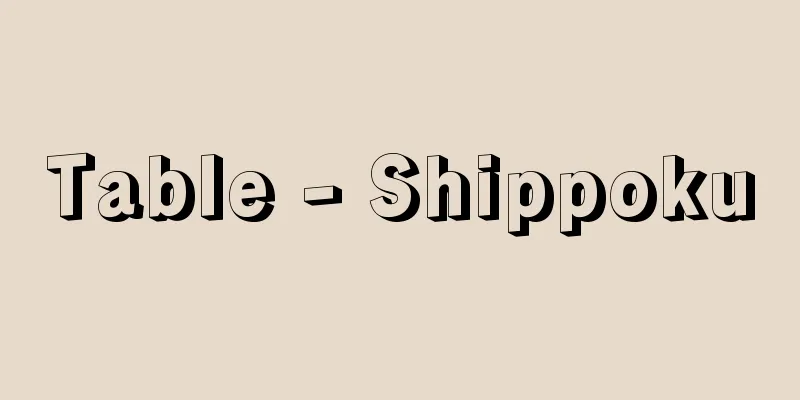Table - Shippoku

〘Noun〙 ("Shitsu" and "Hoku" are the Chinese pronunciations of "Table" and "Pouch" respectively)① A cloth used to cover a Chinese-style dining table. Also, by extension, it refers to a four-legged table about one meter high painted with vermilion lacquer. Shippoku-dai. Shippo-kodai. [Wakun Shiori (1777-1862)]② An abbreviation of "shippoku ryori (table-style cuisine)." ※Ukiyo-zoshi, Shogei-sode Nikki (1743), vol. 4 "They put their chopsticks in and ate something called shippoku, which was boiled in the same pot."③ Soba or udon noodles topped with ingredients such as kamaboko, mushrooms, and vegetables, and then poured over with sauce. ※Kabuki: Colored Otogi-gusa (Otsuma Hachirobei) (1808) Finale: "'Is there any soba noodles for you to eat? I'll even feed you earthworms .' 'I'll make you some shippoku or noodle noodles .'"Shippoko [table]Chabu [table]Source: The Selected Edition of the Japanese Language Dictionary About the Selected Edition of the Japanese Language Dictionary Information |
〘名〙 (「しつ」「ほく」はそれぞれ「卓」「袱」の唐音)① 中国風の食卓をおおう布。また転じて、四本脚のついた、高さ一メートルほどの朱漆で塗った食卓をさしていう。しっぽくだい。しっぽこだい。〔和訓栞(1777‐1862)〕② 「しっぽくりょうり(卓袱料理)」の略。※浮世草子・諸芸袖日記(1743)四「しっぽくとやら申して、一つの鍋で煮た物を、そうぞうが箸を入れて喰ひあひ」③ そば、またはうどんに、かまぼこ、きのこ、野菜などの具をのせて、かけ汁をかけたもの。※歌舞伎・彩入御伽草(おつま八郎兵衛)(1808)大詰「『うぬに食はせる蕎麦があるものか。蚯蚓(みみず)でも食はしてやらう』『しっぽくか、にふ麺(めん)にせう』」
しっ‐ぽこ【卓袱】ちゃ‐ぶ【卓袱】出典 精選版 日本国語大辞典精選版 日本国語大辞典について 情報 |
Recommend
Marine Aquaculture - Sponge Farming
The cultivation and harvesting of aquatic plants a...
Kairai (■1)
...The "Soka no Gaku" was a form of mou...
Debilität (English spelling)
…Their intellectual age is 6 to 7 years old, and ...
Julius (family name) (English spelling) Julius
…the family name of the first 5 Roman emperors. T...
Scaphopoda
…the name of a species of mollusca in the class S...
Monetary compensation - Kinsenbaisho
The term "damages" refers to damages pai...
Ishijo Mountain - Iwakisan
This mountain is located in the southeastern part...
Kassapa [I] - Kassapa
…It is a rocky mountain about 180 meters above se...
Caracal - Caracal (English spelling)
It is a member of the Felidae family of the Carni...
Carissa
…It is an evergreen shrub of the Apocynaceae fami...
Basic utility function
...A function that converts the utility of things...
Ibn al-Amid
…Born in Cairo and died in Damascus. Known as Ibn...
The Tale of the Great Go and Peace by Shiraishi
Joruri Gidayubushi. Jidai sewamono. 11 acts. A co...
Carrington, RC - Carrington
...Observations to determine the relative number ...
Pteris nipponica (English spelling) Pterisnipponica
…[Masahiro Kato]. . . *Some of the terminology th...









